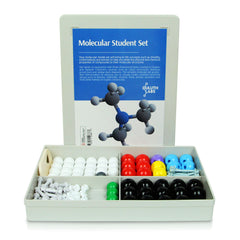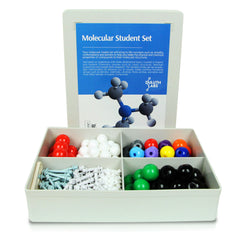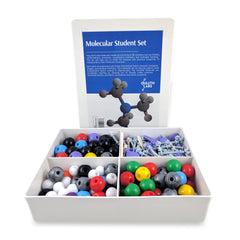Duluth Labs Molecular Set Instructions
Duluth Labs Model Set
Download Your Instructions
- MM-003 Student Set Instructions
- MM-004 Student Set Instructions
- MM-005 Student Set Instructions
- MM-007 Student Set Instructions
Disassembly of Molecules

Molecular Tool
Methane
One of the simplest organic molecules is methane with a molecular formula of CH4 meaning it contains one carbon and four hydrogens. A 3-dimensional representation of a methane molecule is shown below.
To create methane with your molecular set, first find a black carbon atom and four white hydrogen atoms. Since the hydrogen atoms connect to the carbon atom by single covalent bonds, either four short connectors (creates more compact models) or four medium connectors can be used. Simply attach one side of the connector to a hole in the carbon atom and the other side to a hydrogen atom. Once you've connected all of the hydrogen atoms to the carbon, you've created your first molecule and can show your family or friends what natural gas molecules look like.


Butane
Butane is an alkane that has a total of four carbon atoms, ten hydrogen atoms and a molecular formula of C4H10. Since butane has two structural isomers, we will be more specific that that we're going to build normal butane (also written as n-butane). Normal butane can be used as a fuel and is commonly mixed with propane to create Liquefied Petroleum Gas or LPG. It can also be used as a blend stock in gasoline or as a propellant in aerosol sprays.
To build normal butane, you'll need four black carbon atoms, ten white hydrogens and thirteen short or medium connectors. First, attach all the carbons together in a line with single covalent bonds. Fill in the rest of the available bonds from the carbon atoms with the ten hydrogens and now you've got n-butane. For extra credit, see if you can figure out which two bonds to switch around to easily change the molecule into iso-butane:)


Cyclohexane
The next molecule that we'll build is cyclohexane which is classified as a cycloalkane. Since cyclohexane's molecular formula is C6H12, you'll need six black carbons and twelve white hydrogens (along with eighteen small or medium connectors) to build this molecule. To start on this molecule, first connect the six carbons together into a circle. Once you have the carbon ring, fill in the rest of the carbon bonds with white hydrogen atoms.
The cyclohexane molecule that you just made can be really helpful to understand conformations. Cyclohexane can flip its ring to rotate between chair and boat conformations. The 3-dimensional picture of cyclohexane shows the molecule in its chair conformation which is the lowest energy state or most stable structure. The Duluth Labs set has been designed so you can easily flip cyclohexane from the chair to the boat conformation to see the differences between the two. Another useful topic that you can use your model to visualize is equatorial or axial locations of substituted cyclohexane. One way to do this is to substitute one hydrogen atom with a green halogen atom. With the cyclohexane molecule in the chair conformation, the green halogen atom will either be in the equatorial (essentially on the outside of the ring) or in the axial position. By rotating the carbons in the cyclohexane ring, you can change the position of the halogen from equatorial to axial and back again.

Cyclohexane Axial

Cyclohexane - Chair Conformation

Cyclohexane - Boat Conformation

Cyclohexane Equatorial

Trimethylamine
While the first three molecules we've built just have hydrogen and carbon atoms, the next one that we'll build also contains nitrogen. Trimethylamine has a formula of N(CH3)3 which is a tertiary amine. Trimethylamine is found as a byproduct of decomposing plants and animals and produces an odor typically associated with rotting fish. While your Duluth Labs set has been designed to accurately visualize numerous organic structures, it does not simulate the odors of these molecules so you don't have to worry about a rotten fish smell when you build it:)
To build this molecule, you'll need three black carbons, nine white hydrogens and one blue nitrogen with three holes in it. Note that your set includes two blue nitrogen atoms with three holes and two other nitrogen atoms with four holes. Since nitrogen can form molecules with three covalent bonds (like trimethylamine) or four covalent bonds (like ammonium), we included both types to allow more flexibility for building these different molecules. To create trimethylamine, connect the three black carbons to the nitrogen atom. After you do that, you can build the rest of your methyl groups by adding in the other three hydrogens to each carbon.


Alanine
Alanine's chemical formula or CH3CH(NH2)COOH looks intimidating but we will walk our way through creating this amino acid. The left handed isomer (or L-isomer) of alanine is one of the twenty amino acids that is found in the human genomic code. To build this molecule, you'll need three black carbons, two red oxygens, one blue three bond nitrogen and seven hydrogens. Since this molecule contains a double bond between one of the oxygen atoms and a carbon, we'll need to use two long connectors for this double bond along with eleven medium connectors for the single covalent bonds.
To make this atom, we can start by making all of the functional groups in the molecule. First, we can make the carboxyl group which is the COOH part of the formula (shown at the top of the 3-dimensional picture below). To make the carboxyl group, connect a red oxygen to a carbon with a medium covalent bond and add a hydrogen to the other available bond of that oxygen. Next, use two long connectors to create a double bond to connect the other oxygen to the carbon atom.
Now you can also make a methyl group (-CH3) and an amine group (-NH2) to build the other functional groups of alanine. Finally, you can connect these three using medium covalent bonds to a final carbon and finish off the molecule by adding the last hydrogen atom.


Benzenesulfonic Acid
Benzenesulfonic Acid The last molecule that we'll build is benzenesulfonic acid which has the chemical formula of C6H5SO3H. To build this molecule, you'll need a total of six black carbons, three red oxygens, one six bond yellow sulfur and six white hydrogens. The molecule also contains five double bonds so we'll need ten long connectors and eleven medium single covalent bonds. Like nitrogen, sulfur can have a varying number of covalent bonds in different molecules so two different yellow sulfur atoms were included in the your set. The sulfur atom with four holes can be used to make sulfur compounds with four covalent bonds like sulfur dioxide, SO2, or sulfur compounds with two covalent bonds like hydrogen sulfide, H2S (for this type of molecule you'd just leave two holes open on the four hole sulfur). The sulfur with six holes can be used to make molecules like benzenesulfonic acid where sulfur has a total of six covalent bonds.
We'll break this molecule down into two pieces and build the aromatic ring (benzene) and the sulfonic acid groups separately at first. To create benzene which is an aromatic ring, you'll need the six carbons and a total of five hydrogens. Connect the carbons together alternating between single and double bonds until the six carbons have formed a ring. Fill in the open holes on the carbon atoms with the five hydrogens and leave the last carbon bond open to connect to the sulfonic acid group.
To create the sulfonic acid group, you'll need to connect two oxygens to the sulfur atom using double bonds. A third oxygen can be attached to the sulfur using a single bond and that oxygen can be saturated with a hydrogen atom. Finally, you can connect these two functional groups together with a single bond to form benzenesulfonic acid. Great work!





